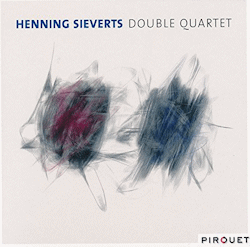Bass Twins
Cantus Firmus
Hexa Countdown
Drum Twins
Vipia Twins
Firm Chant
Cantus Seven
Sax Twins
Hexa Circle
Hexa Twelve
Hidden Hexa
Ebird
Fasoldo
Ursin
Bass Twins [Reprise]
There’s a historico-musical context to Henning Sieverts’ latest disc. It concerns the history of the Bavarian Irsee Monastery and a Mass written in 1614,
elements of which are incorporated into Sieverts’ 15-movement ‘suite’. Lest that sounds like a recipe for cross-stylistic outrage, it should be stressed
that any absorptions are very subtle and most will not hear any ghostly imprint of early seventeenth-century liturgical music in any way.
So perhaps it’s best to listen to this album in a more straight-ahead kind of way. Bass Twins opens with a drunken lurch for tuba and bass but a
different slant on Sieverts’s band comes in the more conventional Cantus Five where pianist Florian Weber proves an active and engaging player and
the two-drum team offeris crisp support to the jubilant anthemic saxophone statements. It’s not hard to hear that Weber’s classical allegiances are
strongly held – in Hexa Countdown his harmonies and chordal progressions are strikingly classically-based – but this is in the context of a
colourful, sonically exciting band, rhythmically vivid too. Cleverly the ABA structure of this piece offers the most rooted of architectural principles.
With two saxes, and two drums, the opportunities for exchange and interplay are always there; the brief one-minute exchange for the drummers in Drum Twins is followed by the almost-as-short romantic piano-and vibes reverie of Vipia Twins. These elements recur in other tracks too,
where the full ensemble sound breaks down into aggregations of individual sound-worlds and the segments become populated by a rich exchange. Note how this
works in the firm up-tempo delights of Cantus Seven or indeed how the two-man sax section of Loren Stillman and Silvian Rifflet coils around each
other in the intermezzo that is Sax Twins. Whether evoking chorale-like themes via sax and clarinet voicings, or jauntily trading off tuba and
bass grumblings – the leader’s bass playing here is as articulate and rich as ever and evokes a New Orleans vibe – there is plenty to enjoy, amuse and
entertain in this sonically gleeful set of pairings, entwining, evocations, refractions and good old honest fun.
Jonathan Woolf
